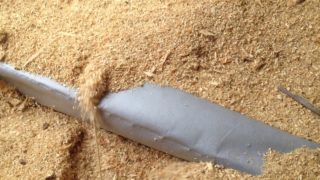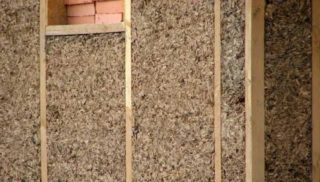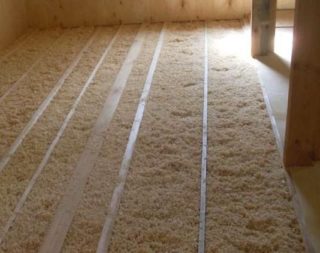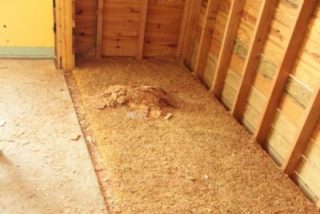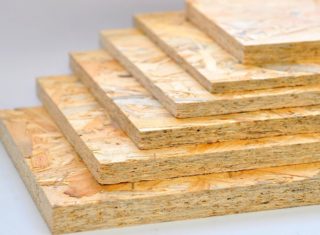Despite the appearance of a large number of various heaters of a modern type, warming with sawdust does not lose relevance. This is an environmentally friendly and inexpensive material with good thermal insulation, which is most often used during the construction of private houses. Insulation from sawdust can be prepared independently or purchased ready-made at a woodworking enterprise. Before using such material, it is worthwhile to study in advance how to use it and the installation process, which has its own nuances.
Pros and cons of warming with sawdust
Sawdust as a heater can be used to work with any elements of the house, including attics, floors, walls, cellar and much more. This material should be subjected to special processing, only in this case it will fit into the complex of construction works. All electrical cables crossing the insulation layers must be insulated, also pay great attention to the thermal insulation of chimneys in those places where they pass through the floors of attics.
Sawdust, used as a ceiling insulation or for other parts of the room, is divided into several varieties depending on the type of wood. The best choice is oak sawdust, which has low hygroscopicity when compared with analogues of other wood species. They are least affected by the spread of rot and are not able to swell when water enters. In addition to oak, coniferous waste, such as larch, pine or spruce, is suitable for thermal insulation.
The list of the main advantages of the material includes:
- increased level of environmental friendliness, since sawdust does not emit toxins;
- very low price;
- the ability to use the material in bulk or other condition, for example, in combination with natural or synthetic materials.
The main disadvantage of sawdust or sawdust concrete is a high level of combustibility. If you use the material in combination with clay or concrete, its flammability decreases sharply.
Scope of application
Bulk material is suitable for coatings in buildings where there is a basement or insulated basement, ceilings over a cold basement and external walls. It is also used for ceilings on the upper floors, if the plans include creating a cool attic, or a technical floor and pitched roofs, if you need to install an attic.
Walls
It is advisable to heat the walls with sawdust using waste from processed wood from hardwoods, for example, pine, spruce, ash or oak. Oak is considered the most suitable option, although the most expensive. It helps to keep heat in an initially cold room even in frosts down to -30 degrees. A good choice would be coniferous shavings containing a large number of resins that repel insects or rodents. For warming, they take sawdust of the middle fraction, since small ones create a lot of dust, and large ones are not able to retain heat.
Sawdust should not have any impurities and odors, for this purpose they are subjected to drying in a chamber. Chips with optimal moisture are dried in air, and sawdust is never used without thorough antiseptic treatment.
Ceiling
Insulation of the ceiling with sawdust is mainly carried out using the dry method, during which the material is not mixed with binders. The warm layer is as light as possible and does not create additional load on the floors.Do-it-yourself insulation of the ceiling with sawdust in a private house can also be done using sawdust mixed with cement or clay. The procedure itself begins from the attic side, before this, formwork is installed from boards with a width of at least 20-35 cm. Care must be taken that the fasteners are strong enough, since the sawdust “pillow” weighs a lot.
All wood structures are treated with flame retardants or antiseptics to reduce flammability, protect against mold, fungal organisms and rot. It is important to protect the insulator from water, for this a layer of vapor barrier is put on the ceilings, gluing the joints of the joints with tape or bitumen. Then sawdust is poured onto the vapor barrier with a layer of 20-30 cm. If the dry method is chosen, all layers are crushed and slightly moistened with a spray gun, then after precipitation another layer is added and sprinkled with ash. With the wet method, the insulation is allowed to dry completely for one month.
In order to qualitatively insulate the ceiling with wood sawdust, the cracks formed during the drying process should be covered with liquid clay or cement mortar.
Floor
It is advisable to heat the floor with sawdust by mixing the source material with lime or pouring boric acid into it in the form of a solution. For the floor, it is worth taking ordinary carpentry sawdust, since it is much easier to work with them, unlike wood concrete or sawdust concrete. The source material is well dried, before work put slaked lime in it to scare away rodents and insects. The filling is carried out in two layers, the height of the bottom can be no more than 10-15 cm, after it is carefully tamped.
As a second layer, sawdust is poured to fill the voids in the chips, after which the final tamping is carried out. The thickness of the main layer should be at least 30 cm. It is left for 2-3 days, if it settles, you will need to re-bring the layer to the required level. In the process of warming the floor with sawdust in a wooden house, the presence of a clearance for ventilation is checked before the flooring of the finishing layer. The dry method is rarely used when it comes to gender. Most often, cement or clay is added to the sawdust, which protects the material from decay and accidental fire.
Roof
Insulation of the roof of the house with sawdust is carried out in order to prevent heat loss and ensure good thermal insulation of roof structures. The material is poured into the gaps between the lags of the floors of the attic with a layer of at least 15-30 cm, after adding auxiliary components to it, for example, clay. The most effective option is a mixture of sawdust material with clay. To prepare this insulation, water is poured into the clay to soak. Then it is combined with sawdust in a special mixer or barrel. To achieve the perfect result, preparation and the main stage of laying should be carried out according to the rules.
How to mix sawdust
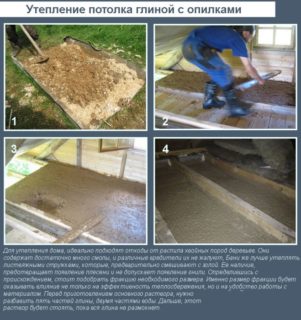 When insulating an attic or floor with sawdust, it is important to choose the right binder component. Basically, clay, gypsum, cement or lime are chosen for this purpose, each substance has specific properties that should be remembered when choosing.
When insulating an attic or floor with sawdust, it is important to choose the right binder component. Basically, clay, gypsum, cement or lime are chosen for this purpose, each substance has specific properties that should be remembered when choosing.
Sawdust can not be used in its original form, they are able to cake together, forming empty spaces in the insulation layer, rodents and insects often settle there. An additional component disinfects the sawdust layer and makes it more convenient for installation.
Lime
Lime helps prevent the formation of pathogenic microorganisms, protects the insulation from rot and other problems. It is a strong alkali, therefore, insects will never start in the sawdust layer with lime. It is used to prevent the entry of larvae of beetles and rodents, as well as in the form of an astringent, but in this quality lime is noticeably inferior to other components. Nevertheless, lime is always recommended to be added to the sawdust layer.
Cement
Cement is not too comfortable, it hardens for a day, and it is much more difficult to apply to the wall covering. This is the most durable cementitious component, the combination of sawdust and cement is suitable as a plaster for walls on the outside, filling ceilings, spaces under the floor, and also as a composition for filling the walls inside. After solidification, it is a loose, but solid stone of a gray shade, its color can be changed if additional coloring components are added to the initial mass in the required proportion.
Clay
Clay is the cheapest binder, which has many advantages. The main disadvantage is that due to the effect of water, the dried layer of the mass is able to become sour. During the drying process, clay is able to lose mass during the evaporation of moisture, but in strength it is practically not inferior to gypsum and cement. This is a convenient and completely plastic material that does not cause problems during installation.
Gypsum
Gypsum is no less popular due to its ability to harden quickly, the composition based on it hardens in 10 minutes and completely dries out after 2-3 hours. Sawdust insulation based on it is strong enough and light in weight; dips and cracks do not appear in it. Compositions with gypsum are not used for insulation without decoration, since this component is destroyed due to moisture.
The use of pressed sawdust
Pressed sawdust is suitable not only for heating, they are also used in the form of insulation in private buildings and saunas. Special boards made of wood fiber and sawdust, processed by pressing, exceed standard sawdust in terms of efficiency. Antiseptics or flame retardants are always added to the material for their creation, increasing the resistance of the plates to negative influences. Their installation is carried out in a few hours, but for such plates necessarily require additional coating.
How is the styling
The process of laying sawdust should be described on the example of insulation of the attic in a residential or commercial building. During insulation with sawdust, you need to weigh the pros and cons, then familiarize yourself with the technology of their installation.
First, they prepare the surface for the thermal insulation coating, cover the cracks with clay or fill with mounting foam to improve the quality of thermal insulation. In the presence of a chimney, in order to protect against fire, the area around it is covered with non-combustible type material, for example, slag.
For the attic, sawdust with a small fraction is often used, kneading them with 10% lime and 5% gypsum, first treated with boric acid and dried. All substances are combined in containers and water is added to slightly moisten the sawdust layer. Next, the solution is distributed over the entire surface of the attic with a dense layer of a thickness of not more than 25 cm, compacted and waiting for complete solidification. After the floor is laid on top, made of the most suitable material, which will become an ideal coating if the installation is carried out according to the rules.
